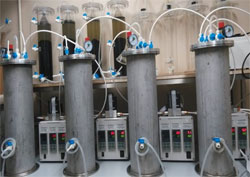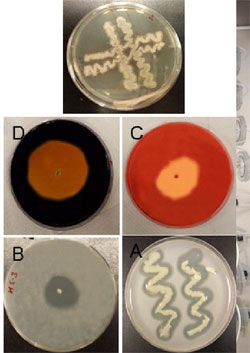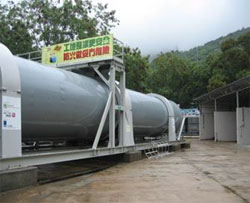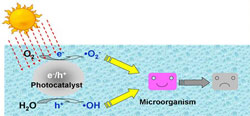Two leading scholars have been invited to deliver public lectures on Waste Treatment organized by the Research Grants Council with the Hong Kong Science Museum on 9 May 2015 (Saturday). Details of the lectures are as follows:
| Topic | Speaker | Time |
|---|---|---|
| Food Waste Management - Waste to Resource | Professor Jonathan Woon-chung WONG (Professor, Department of Biology, Hong Kong Baptist University and Director, Sino-Forest Applied Research Centre for Pearl River Delta Environment) | 2:30 pm - 3:30 pm |
| Photocatalytic Technology for Pollution Treatment | Professor Jimmy Chai-mei YU (Professor, Department of Chemistry, The Chinese University of Hong Kong) | 3:30 pm - 4:30 pm |
Venue: Lecture Hall, Hong Kong Science
Museum (Location
Map)
Language: Cantonese
Free admission on a first-come, first-served
basis.
For enquires, please contact us at 2524
3987 or rgc@ugc.edu.hk.
First Session
Topic: Food Waste Management - Waste to
Resource
Speakers: Professor Jonathan Woon-chung
Wong
Time: 9 May 2015 (Saturday) 2:30pm - 3:30pm
|
Brief introduction: In Hong Kong, we generate about 3500 tonnes of food wastes every day, and most of them are landfilled occupying precious landfill space and resulting in negative environmental impacts. Through a 'Cradle-to-Cradle' approach, food waste can be directed towards an integrated treatment approach leading to zero-waste disposal simultaneously generating energy that can offset the Region's energy purchase. High moisture content of food wastes makes it unsuitable/economically non-viable for thermal technologies, leaving the biological treatment as the most environmental friendly choice. Composting and anaerobic digestion (AD) are the conventional technologies for large scale operation for converting food waste to organic fertilizer and energy respectively The methane produced through AD can be used to generate electricity or can be integrated into the Towngas network thus the existing distribution system can be used. If all the food waste generated in Hong Kong is treated through AD, electricity required for ~4% of the HK households can be generated. Another potential treatment option is the composting that can recover the nutrient from the waste in the form of compost which can reduce the dependence of the inorganic fertilizers. Besides, the humus content of the compost provide a better structure for the soil and provide long-lasting benefit to the crops. Other possibilities of industrially relevant technologies such as production of fish feed and biodiesel are also attractive and gaining attention as energy-recovery technologies. The food waste or the AD digestate can be used as the substrate to grow the oil accumulating microbe, which can be extracted to produce biodiesel. Thus, myriad opportunities exist but the local demand & supply and long-term benefits should be given priority in selecting appropriate technologies. Furthermore, integrating the technologies provide opportunity to complete the 'recycling loop' of energy and nutrients. This presentation will provide an overview of available technologies, suitability to both Hong Kong and other countries, benefits and key challenges of recycling the resource 'Food Waste'. About the Speaker: Jonathan Wong is currently a Professor in the Department of Biology at the Hong Kong Baptist University where he has taught since 1992. He is also the Executive Director of Earth Tech Consultancy Co. Ltd. providing environmental consultancy service. He received his B.Sc. (Hons.) and M.Phil. in Biology from the Chinese University of Hong Kong and his Ph.D. in environmental science from Murdoch University, Western Australia. He is currently the Director of the Sino-Forest Applied Research Centre for Pearl River Delta Environment and Hong Kong Organic Resource Centre (HKORC). He is one of the founders of HKORC and has developed the first third party certification system of Hong Kong, currently providing certification for local and overseas organic farming and processing operations. He has been invited as a visiting professor of Nanjing Agriculture University, China Agriculture University and Shandong University. He has conducted research exploring the reutilization of organic wastes for energy and biomass production, developing innovative composting technology, anaerobic digestion of food waste, waste separation and recycling, and remediation of soils contaminated with PAHs, pesticides and heavy metals. He has been a principal investigator in projects worth more than HK$70 million, and is the author or co-author of over 350 SCI publication and conference proceedings. Jonathan has been active in promoting environmental protection and conservation in Hong Kong, and has been appointed as a member of a number of Government's advisory committees including Chairman of the Advisory Committee on Agriculture and Fisheries, Vice Chairman of the Environmental Campaign Committee, Member of the Advisory Council on Environment, Member of the Expert Committee of the Centre for Food Safety and etc. Prof. Wong was bestowed with Medal of Honor by the Government of Hong Kong Special Administrative Region in 2011 for his service and contribution to the Environment, and appointed as Justice of Peace. |
Laboratory setup for anaerobic digestion
Bacterial consortium for degradation of oil and fat in food waste
In-vessel composter at Ngau Tam Mei Animal Waste Composting Facility |
Second Session
Topic: Photocatalytic Technology for Pollution
Treatment
Speaker: Professor Jimmy Chai-mei Yu
Time: 9 May 2015 (Saturday) 3:30pm - 4:30pm
|
Brief introduction: As air and water pollution becomes more and more serious, the development of efficient and green purification and disinfection technologies becomes increasingly critical. Photocatalytic materials can absorb harmful ultraviolet radiation, degrade pollutants, and kill bacteria on contact. With support from the Hong Kong SAR Government, we have developed methods to fabricate nano-sized photocatalysts and mesoporous thin-film coatings. These durable materials have immense industrial potential. Air Treatment/Water Treatment System
employing Photocatalytic Oxidation
Technology (PCO) provides the most
efficient way to remove bacteria and
pollutants from air/water. The PCO
core system involves the action of
a low UV energy, activating a Titanium
Dioxide (TiO2) based catalyst surface
which, in the presence of air /water,
generates hydroxyl radicals (¡EOH)
that oxidize pollutants, bacteria
and viruses and convert them into
harmless carbon dioxide and water. About the Speaker: Jimmy Yu graduated from St. Martin's College in 1980, and received a Ph.D. degree from University of Idaho in 1985. He joined The Chinese University of Hong Kong in 1995, and was promoted to Professor in 2002. He is now Head of United College and Associate Director of the Institute of Environment, Energy and Sustainability. Professor Yu is a leading scientist in the research field of photocatalysis. He holds six patents on photocatalytic nanomaterials, and shared a 2005 State Natural Science Award with collaborators. He has published 300 scientific articles that received almost 20,000 citations. His name appears on the prestigious list of Thomson Reuters Highly Cited Researchers 2014. Professor Yu is active in public service, serving on the Board of Air and Waste Management Association-Hong Kong. He is also an Advisor for Friends of the Earth-Hong Kong. He is Associate Editor of Journal of Nanoparticle Research, and serves on the Physical Science Panel of Research Grants Council. He was named Chang Jiang Scholar Chair Professor by the Ministry of Education, and was appointed Honorary International Chair Professor by National Taipei University of Technology. |
Photocatalytic Disinfection |



